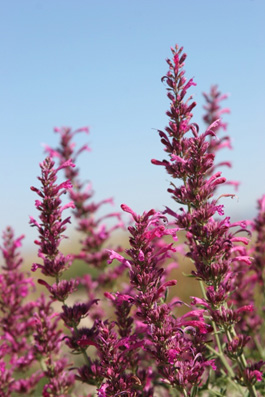Bubblegum Mint in the Landscape

Stephen Love, University of Idaho
Scientfic Name: Agastache canaCommon Name: Bubblegum Mint or Mosquito Plant
Description: Bubblegum mint is an herbaceous, moderately long-lived perennial with shrub-like summer form. The plants die back to a woody crown during winter. Bubblegum mint is relatively tall, typically 36 to 40 inches. The branches are numerous, upright to spreading, and moderately open. The leaves are small to the point of being nearly inconspicuous. The large flower spikes, that cover the plant in late summer and fall, are spectacular and more than make up for the leggy foliage. The flowers and colorful bracts are dark pink to violet. The bloom period is unusually late and very long, lasting from early July until hard frost in the fall. The common name, bubblegum mint, refers to the pleasant fragrance of the leaves and flowers. This species is a good subject for xeric beds and borders where fall color is desirable. It is also valuable plant for difficult sites such as parking strips.
Native Habitat: Native to southwestern New Mexico and western Texas. Rarely seen in its native range where it grows on granite outcrops and cliff edges at elevations of 5,000 to 6,000 feet.
Cultural Requirement
Soil: Adapted to a range of soils, including those with high pH. Lifespan is greatest when grown in well-drained sandy or gravelly substrates.
Moisture Tolerance: Although considered a xeric plant, bubblegum mint requires some supplemental irrigation to remain attractive throughout the season.
Sun/Shade/Preference: Requires full sun for best bloom.
Transplanting: Tolerates transplanting well, both from pot to pot and from pot to garden. Plants develop rapidly and do well in pots up to one gallon size.
Propagation: Best from seed. Requires no stratification or other pretreatment. Difficult to propagate from cuttings.
Maintenance (pruning, fertilization, deadheading, division, irrigation, etc): Supplemental irrigation is needed (three to five times during each summer) to keep plants actively growing and attractive. Only occasional, minimal fertilization is needed, as plants demand.
Insect, disease, or other problems: Bubblegum mint has no serious insect or disease problems.
Landscape Value
Use in the Landscape: Bubblegum mint is a large, spreading plant with shrubby form. Its remarkable show of color makes it best used as a specimen plant with other smaller complementary plants. It livens up beds and borders. Bubblegum mint is probably at its best in naturalized designs but also can be used in formal designs.
Foliage: Prior to bloom, the dominant feature of the foliage is the numerous, open, stiff branches. The leaves are small, gray-green and dispersed throughout the plant.
Flower: The flowers grow in long spikes at the ends of the spare-looking stems. The numerous flowers present hues of dark pink to violet. The bracts tending the flowers are also brightly colored, usually violet.
Timing: July Aug Sept Oct
Color: Pink to violet.
Fruit: Four seeds, enclosed in nutlets, develop from each flower. These nutlets are embedded in the dried flowers and are inconspicuous.
Form: Shrub-like, loosely spreading to upright.
Texture: Moderately fine.
Ultimate Size: In bloom - 36 to 40 inches tall; prior to bloom - 30 to 36 inches tall. Width similar to height.
Rate of Growth: Rapid. The plants usually bloom the first year and may bloom in pots prior to transplanting.
Suggested Plant Partners: Plant bubblegum mint with early-blooming wildflowers to extend the bloom season, including Penstemon strictus, Penstemon venustus, Potentilla thurberi, Eriogonum umbellatum, Erigeron elatior; shrubs such as Chamaebatiaria millefolium and Ephedra viridis; and small to moderate-sized grasses such as Schizachyrium scoparium and Festuca idahoensis.
Availability: Easy to find as a potted plant at local or mail order native plant nurseries. Occasionally available at traditional nurseries. Seed can be purchased native plant seed suppliers.
Cultivars: 'Sonoran Sunset', 'Heather Queen', and 'Ava'.
References:

